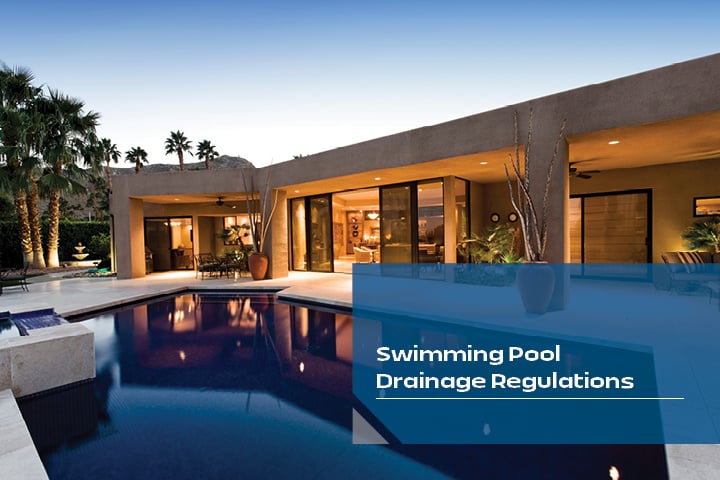Nothing is better during the hot summer than jumping into a swimming pool to cool off!
That's what makes private pools so appealing and why many homebuyers seek homes with pools or properties where they can install one. However, at a certain time, you may wonder: “Where do I drain my pool water?”
Here’s what you need to know about swimming pool drainage regulations.
Standard Regulations for Pool Drainage
Every area can have different drainage regulations, which means one thing:
Before draining your pool, you should always look into your area's swimming pool drainage regulations. The reason is, you could end up with a fine for breaking municipality regulations.

However, most areas generally follow the same guidelines:
Chemical Levels
You must remove the chemicals from the water. Not doing so can damage the local water bodies and harm or kill wildlife. To avoid doing this, remove chlorine and bromine using one of the two methods:
- The Natural Method: Let the pool water sit, open to the sun, for seven to fourteen days without adding new chemicals.
- Chemical Dechlorination: Use a chemical additive from a pool store to dechlorinate the pool.
Test the water using a pool testing kit to verify it is dechlorinated. The total residual bromine levels should be less than 0.1 mg/L, and the pH of the water should be between 6.0 and 8.0.
Appearance of Water
Floating solids and solids at the bottom of the pool should be removed and discarded manually. There should also be no visible foam, oil sheen, algae, color, or odors except in trace amounts.
Temperature of the Water
For heated pools, temperatures need time to stabilize to ambient conditions before they can get discharged. This will prevent thermal pollution, protect the local ecosystem, and keep aquatic life safe.
Quantity of Water
Some municipalities designate times when you can and cannot drain your pool. Avoid draining pools during rainy seasons because it can overwhelm the sanitary sewage system, and your lawn.
Drain pools slowly, over a few days if necessary, to prevent overwhelming the environment or sewage system.
Where Can I Drain My Pool Water? The Different Methods
The drainage method is where swimming pool drainage regulations can vary greatly. It doesn't only depend on your municipality, but also on the type of pool you have.
First, you need to know where you should avoid draining your water. You should not drain dechlorinated pool water directly into a storm drain or stream unless it is a last resort. You also want to avoid creating puddles of standing water or water entering your neighbor's property. No matter what, you never want to drain pool water into your septic system because it can cause it to fail.
Drainage Via the Sanitary Sewer System
You can drain your pool into the sanitary sewer system, which most in-ground pools are connected to. To use this method:
- Find your property's sanitary sewer cleanout outlet or use a sink or bathtub.
- Connect a pump to the cleanout or put a hose in the sink or tub to ensure that it drains at no more than 20 gallons per minute.
- Once set up, you can start pumping the pool water to your chosen outlet.
Can I Drain My Pool Water On the Lawn?
Draining your pool onto your property is often the preferred method. You will need to drain it into a vegetated area of your property, which includes your lawn, garden, or similar area where water can percolate into the ground. Before discharging the water, you also must ensure:
- You will not flood your neighbor's or any other adjacent properties.
- The land area is sufficient to prevent ground erosion and runoff into ditches, creeks, or other conveyances, like storm drains.
- The drainage will not be harmful to the environment.
Where Do You Drain Pool Water from Saltwater Pools?
Similar to normal pools, you cannot drain saltwater pools into storm drains or streams. Options for drainage include:
Discharge Into the Public Sanitary Sewer System
As with a chlorinated pool, you can drain your saltwater pool into the public sanitary system via a bathtub, sink, or floor drain. Before draining it, it is important to:
- Ensure that the water is free from debris and sediment.
- Ensure that the plumbing is adequate to handle the pool's flow rates.
Hiring a Company
You can also choose to find and hire a licensed sewage handling service to collect and dispose of the salt pool water properly.
Slot Drain for Pool Drainage

A pool drainage system is an easy, efficient method for draining your pool into the sanitary sewage system without worrying about flow rates or property damage.
The Slot Drain offers sleek, grateless linear channel drains with durable construction and excellent flow rates (measured per foot of drain). Notable options include:
The 7,000 Series: This ADA-compliant system has a .5" wide opening and offers a Load Class C. It offers flow rates of 11 GPM. The 7,000 Series is compatible with Slot Drain's Flush Flo system for easier, semi-automated cleaning.
The 6,000 Series: The 6,000 Series Slot Drain offers three opening widths: the ADA-compliant .5", 1", and 1.25". These widths offer flow rates of 11, 18, and. 27 GPM, respectively. The system also offers a Load Class C and is compatible with Flush Flo and Clean in Place (CIP) systems.
The 4,000 Series: Like the 7,000 Series Slot Drain, the 4,000 Series only offers the ADA-compliant .5" width, with 11 GPM flow rates. It has a Load Class C and is compatible with Flush Flo.
All three of these options are constructed using T304 or T316 stainless steel, which is a highly durable material that offers bacteria and corrosion resistance. They are compatible with Slot Drain's stainless steel, load-bearing Catch Basin, which can help catch fallen objects and debris to keep them out of the drain channel and the sewage system.
Safely Draining Your Pool
You don't have to drain your pool often, but when you do, it is important to understand the swimming pool drainage regulations so you can drain it safely without incurring civil penalties or fines. The Slot Drain can help make pool drainage safer and more efficient while protecting pool water from splashing onto your pool deck once it is filled.
Contact the experts at Slot Drain today to learn more about our systems and how they can help with pool management, including drainage.


